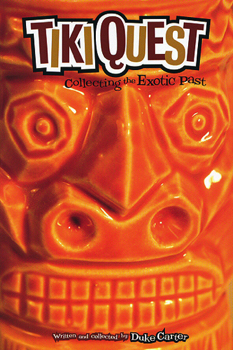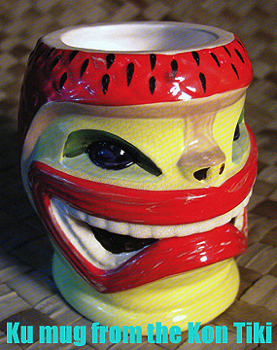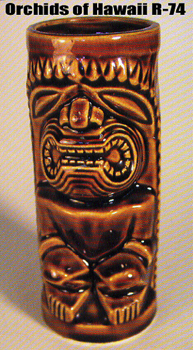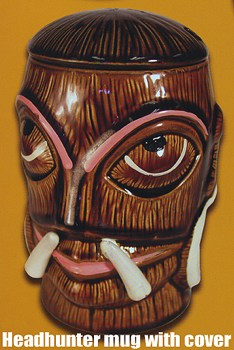THE QUEST FOR TIKI
A Chat with Duke Carter
: : Do I even need to start this by telling you that Tiki mugs are an important part of the overall Tiki experience? Think about it. You’re sitting in a big rattan chair in your favourite Tiki bar… the lights are twinkling off the floats and blowfish hanging overhead… the lilting sounds of some old exotica record (mixed with jungle bird calls, of course) make their way through the bar to your ears to further lull you into a state of after-dinner numbness. You’re stuffed to the gills with everything the pu-pu platter had to offer… you decide to order another Suffering Bastard. Doesn’t the whole experience seem so much better when your drink shows up in an actual Suffering Bastard mug, rather than in a plain old glass? : :
: : Yep, Tiki mugs are a BIG part of the Tiki experience. I don’t know any Tiki-phile who doesn’t have at least a couple of old (or new) mugs sitting around on a shelf at home. But for some, the collecting of Tiki mugs borders on obsession… : :
: : Duke Carter (whom many in the Tiki community know for his paintings featured in the book Taboo: the Art of Tiki) has been collecting Tiki mugs and other paraphernalia with his wife Amy for nearly a decade. For Duke, collecting Tiki has developed into more than just a hobby... it has become a Tiki Quest. : :
: : Like many Tiki fans, Duke and Amy became enchanted with Tiki through mugs they found in thrift stores and flea markets. Duke claims that was the spark that set the fire. “Once we began to re-discover the magic of Tiki, we became obsessed with all aspects. It seems like a common thread among many of the collectors we have gotten to know. Many of us are thrift junkies with a genuine interest in many facets of popular culture from the past that society had decided to dismiss or cast off. We are very interested in design and aesthetics, and inquisitive by nature. When you find a crazy ceramic mug with the name of a restaurant on it, or an amazing record of off-beat jazz with bird calls, you are compelled to find out more.” : :
: : Duke recently catalogued a large portion of his and Amy’s collection in his book Tiki Quest: Collecting the Exotic Past. Even at close to 200 pages and illustrated with over 1000 photos, the book does not catalogue the Carters’ complete collection. What the book does do, however, is truly succeed in communicating the thrill of collecting Tiki. : :
: : “That was our hope and intention all along,” says Duke. “We approached a few publishers about doing the book. Some rejected it outright, others were interested but they wanted to push us in a direction we did not want to go. They all wanted us to include a price list or value guide, which we were adamant about NOT doing. We did not want to contribute to price inflation or have ebay sellers using the book to milk the most from their auctions. We wanted our book to be a nice coffee table book that looked more like an art monograph than a collectibles guidebook. We also felt that books with price guides are instantly obsolete as soon as they are released. Often that is the intention… so a second edition with "revised prices" can soon be marketed. Our hope was for Tiki Quest to have some longevity.” : :
: : The book is obviously a thrill for Tiki-philes… and opting to publish it as a coffee table book seems to have been a smart decision, as even non-Tiki fans can find some aspect of it to interest them. “It was our hope that it would be interesting and well designed and full of enough intriguing imagery that it would have broad appeal. We hoped that maybe Tiki Quest might turn some people on to Tiki who had not been fans before” says Duke. : :
: : Even the most casual Tiki collector can get a kick out of leafing through the book and finding a mug they may have had sitting around the house for years. And for the more serious collector, the book provides some historical background about the designers and manufacturers of the featured mugs, although Duke would have liked to delve into even more detail. “The historical information I included was what I had learned from years of collecting” Duke says. “I have a few old catalogues and some literature but there are other collectors who have much more than I do. It's been through conversations, some ‘show and tell’ and shared interest that I picked up a lot of the background I have. If I had been more ‘hard-core,’ someone suggested I'd have gone to Japan to find the old factories and research the origins of the manufacturers of the vintage mugs. I guess I partly like the mystery and intrigue. I guess I'm also kinda lazy and poor. A trip like that would be a lot of work and expensive.” : :
: : In addition to the research involved, another part of putting together Tiki Quest that proved to be a massive undertaking was simply choosing what to put in and what to leave out. The Carters’ collection is huge and is not limited to mugs but also includes other Tiki-related items. “My idea of a collection is something that is always in flux and is growing and changing. We might have two or three copies of the same design which are each a different color or have a different restaurant name but are the same design. Do you count them all or just one unique design? We have a lot of duplicates… sometimes they only show a subtle difference in detail from one generation to the next, some of them are more distinctly different. We really had to whittle down the images when we put the book together. I think I had another 400 or 500 photos I wanted to include, but could not. We left out entire sections like hand-carved wooden Tikis, from the souvenir monkey-pod carvings to mid-size Tikis that were rescued from closed bars. Same with aloha shirts and exotica record covers. They are both areas that most Tiki collectors have a lot of interest in and are rife with Tiki imagery, but again, we just did not have enough room. I'd have loved to include EVERYTHING but it would have ended up as thick as a phone book and probably cost $100 each to print!” : :
: : One aspect of collecting Tiki that the book does disregard is neo-Tiki or newly produced items. While Duke does appreciate neo-Tiki (as do many other Tiki-philes), he feels that collecting vintage Tiki “in the wild” is a richer experience. “I think there is a lot of really nice Tiki stuff being designed and made today. There is some real junk being peddled as well. Tiki Farm is doing a great job in carrying the Tiki torch into the 21st century and I like that they get their mugs into bars and restaurants to be used. I like that the new designs have an informed "self-aware" quality. They reference vintage Tikis but they are different. They don't have the naiveté of the early Tiki designs. I really like the work they do at Munktiki as well. The quality of their hand-made pieces is extraordinary and I like the playful, whimsical nature of a lot of their designs.” : :
: : However, Duke feels that finding an old mug at a swap meet or rummage sale is much more exciting than ordering a new piece online, or being the high bidder on an auction for that matter. “Besides the instant gratification of being able to hold the new acquisition in your hand and run home to add it to your collection, you have added your portion to the history of the object. Say it began life in a kiln in Japan, was boxed and shipped halfway around the world where it was used to serve drinks at a Tiki lounge in Washington D.C. until an overzealous patron snuck it home in their purse as a souvenir of a night out with friends. Then say it sat on the shelf in the back of their kitchen cabinet where they stuck paper umbrellas and swizzle sticks in it until they had to sell the house to move to a retirement community in Florida. Their ‘junk’ was boxed up and sent off to the Salvation Army where someone scribbled $1.25 on the bottom and stuck it on the shelf. You found it, brought it home and displayed it proudly behind your bar. Well, now you are adding your chapter to the life story of that little ceramic mug. Like a lot of people, I think old objects have a history and an interesting story to tell. It's what got us hooked on finding out as much of that story as we could. Personally I'd like to see the vintage mugs remain what they are: relics from the past to be unearthed and cherished.” : :
: : So is “collecting” an unhealthy obsession for those who can’t connect with other people? Or is it exactly the opposite: an opportunity to meet and interact with people you wouldn’t have had any contact with otherwise? Duke thinks that both are probably true. “I do like the social aspects of collecting. Meeting other collectors, talking about our shared interests and seeing what others have discovered. But there is a reclusive element to it as well,” says Duke. “Especially when your focus turns from filling shelves with mugs and statues to creating a complete home Tiki bar environment as ours has. I love that we are capable of shutting the doors, turning on the record player, and having our own tropical escape in the heart of the city. I have always been somewhat awkward in social situations and I have always been a pack-rat, so it would be difficult for me to say one is the result of the other. I do know collectors who have chosen to surround themselves with objects rather than people, so that can certainly be the case. It also goes back to my feeling that it is more rewarding to find Tikis in the real world than cyber-space. It forces you to interact with people and keep some perspective on your particular obsession.” : :
Interact with Duke and Amy by taking a peek at their wonderful collection in
Tiki Quest: Collecting the Exotic Past — www.pegboardchicago.com
John Trivisonno © 2004
CLICK TO ENLARGE PHOTOS





